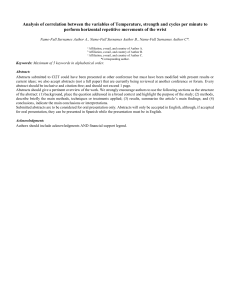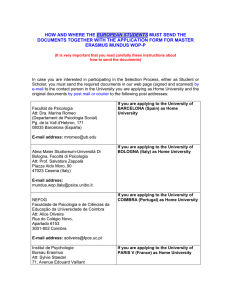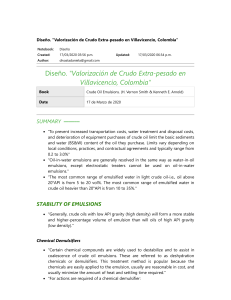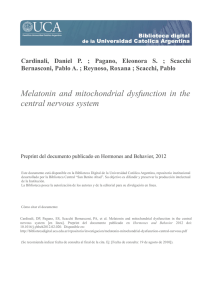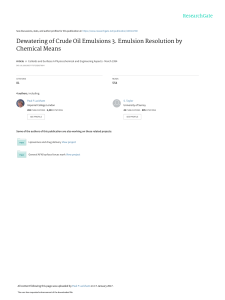Genealogy in the Era of Genomics
Anuncio
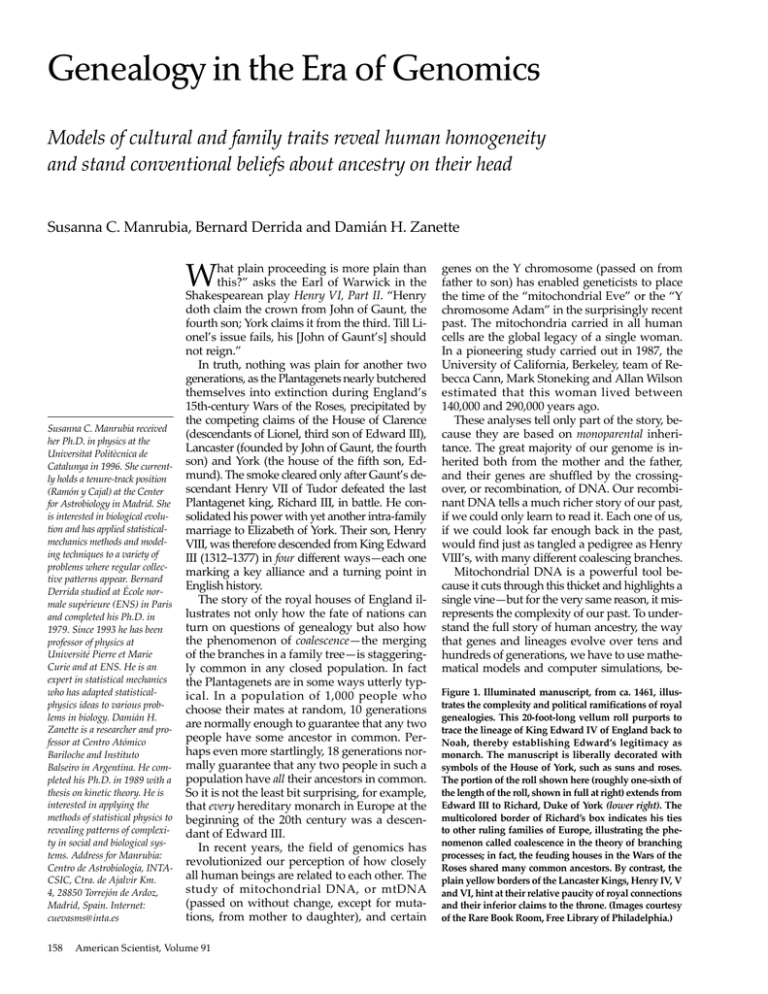
Genealogy in the Era of Genomics Models of cultural and family traits reveal human homogeneity and stand conventional beliefs about ancestry on their head Susanna C. Manrubia, Bernard Derrida and Damián H. Zanette W Susanna C. Manrubia received her Ph.D. in physics at the Universitat Politècnica de Catalunya in 1996. She currently holds a tenure-track position (Ramón y Cajal) at the Center for Astrobiology in Madrid. She is interested in biological evolution and has applied statisticalmechanics methods and modeling techniques to a variety of problems where regular collective patterns appear. Bernard Derrida studied at École normale supérieure (ENS) in Paris and completed his Ph.D. in 1979. Since 1993 he has been professor of physics at Université Pierre et Marie Curie and at ENS. He is an expert in statistical mechanics who has adapted statisticalphysics ideas to various problems in biology. Damián H. Zanette is a researcher and professor at Centro Atómico Bariloche and Instituto Balseiro in Argentina. He completed his Ph.D. in 1989 with a thesis on kinetic theory. He is interested in applying the methods of statistical physics to revealing patterns of complexity in social and biological systems. Address for Manrubia: Centro de Astrobiología, INTACSIC, Ctra. de Ajalvir Km. 4, 28850 Torrejón de Ardoz, Madrid, Spain. Internet: cuevasms@inta.es 158 hat plain proceeding is more plain than this?” asks the Earl of Warwick in the Shakespearean play Henry VI, Part II. “Henry doth claim the crown from John of Gaunt, the fourth son; York claims it from the third. Till Lionel’s issue fails, his [John of Gaunt’s] should not reign.” In truth, nothing was plain for another two generations, as the Plantagenets nearly butchered themselves into extinction during England’s 15th-century Wars of the Roses, precipitated by the competing claims of the House of Clarence (descendants of Lionel, third son of Edward III), Lancaster (founded by John of Gaunt, the fourth son) and York (the house of the fifth son, Edmund). The smoke cleared only after Gaunt’s descendant Henry VII of Tudor defeated the last Plantagenet king, Richard III, in battle. He consolidated his power with yet another intra-family marriage to Elizabeth of York. Their son, Henry VIII, was therefore descended from King Edward III (1312–1377) in four different ways—each one marking a key alliance and a turning point in English history. The story of the royal houses of England illustrates not only how the fate of nations can turn on questions of genealogy but also how the phenomenon of coalescence—the merging of the branches in a family tree—is staggeringly common in any closed population. In fact the Plantagenets are in some ways utterly typical. In a population of 1,000 people who choose their mates at random, 10 generations are normally enough to guarantee that any two people have some ancestor in common. Perhaps even more startlingly, 18 generations normally guarantee that any two people in such a population have all their ancestors in common. So it is not the least bit surprising, for example, that every hereditary monarch in Europe at the beginning of the 20th century was a descendant of Edward III. In recent years, the field of genomics has revolutionized our perception of how closely all human beings are related to each other. The study of mitochondrial DNA, or mtDNA (passed on without change, except for mutations, from mother to daughter), and certain American Scientist, Volume 91 genes on the Y chromosome (passed on from father to son) has enabled geneticists to place the time of the “mitochondrial Eve” or the “Y chromosome Adam” in the surprisingly recent past. The mitochondria carried in all human cells are the global legacy of a single woman. In a pioneering study carried out in 1987, the University of California, Berkeley, team of Rebecca Cann, Mark Stoneking and Allan Wilson estimated that this woman lived between 140,000 and 290,000 years ago. These analyses tell only part of the story, because they are based on monoparental inheritance. The great majority of our genome is inherited both from the mother and the father, and their genes are shuffled by the crossingover, or recombination, of DNA. Our recombinant DNA tells a much richer story of our past, if we could only learn to read it. Each one of us, if we could look far enough back in the past, would find just as tangled a pedigree as Henry VIII’s, with many different coalescing branches. Mitochondrial DNA is a powerful tool because it cuts through this thicket and highlights a single vine—but for the very same reason, it misrepresents the complexity of our past. To understand the full story of human ancestry, the way that genes and lineages evolve over tens and hundreds of generations, we have to use mathematical models and computer simulations, beFigure 1. Illuminated manuscript, from ca. 1461, illustrates the complexity and political ramifications of royal genealogies. This 20-foot-long vellum roll purports to trace the lineage of King Edward IV of England back to Noah, thereby establishing Edward’s legitimacy as monarch. The manuscript is liberally decorated with symbols of the House of York, such as suns and roses. The portion of the roll shown here (roughly one-sixth of the length of the roll, shown in full at right) extends from Edward III to Richard, Duke of York (lower right). The multicolored border of Richard’s box indicates his ties to other ruling families of Europe, illustrating the phenomenon called coalescence in the theory of branching processes; in fact, the feuding houses in the Wars of the Roses shared many common ancestors. By contrast, the plain yellow borders of the Lancaster Kings, Henry IV, V and VI, hint at their relative paucity of royal connections and their inferior claims to the throne. (Images courtesy of the Rare Book Room, Free Library of Philadelphia.) 2003 March–April 159 Edward III (1312–1377) House of Lancaster John of Gaunt (1340–1399) House of York House of Clarence Edmund (1341–1402) Lionel (1338–1368) illegitimate Henry IV (1367–1413) John Beaufort (1373–1410) Joan Beaufort (1379–1440) unification of houses of Clarence and York Richard (1376–1415) Henry V (1387–1422) Roger Mortimer (1374–1389) Anne Mortimer (1390–1411) John Beaufort (1404–1444 Cecily C il Neville N ill (1415–1495) Henry VI (1421–1471) Phillippa (1355–1389) Margaret Beaufort (1441–1509) Henry VII (1455 1509) (1455–1509) unification of houses o Lancaster and Yorkk of (1411–1460) Edward IV (1442–1483) Wars of the Roses House of Tudor (1466–1503) (1466 1503) Henry VIII (1491–1547) Figure 2. Highly simplified genealogy of England’s King Henry VIII shows four ancestral lines that lead back to King Edward III. Genealogical coalescence occurs when both of an individual’s parents share a common ancestor. In the pedigree shown here, there were three such marriages. These were highly nonrandom events, calculated for political effect; the Wars of the Roses were both precipitated and resolved by such unions. However, the authors’ research shows that coalescence occurs surprisingly rapidly in all closed populations, even those where breeding takes place at random. cause we do not have genealogical records that extend so far back into the past. These biparental models show that mitochondrial DNA actually underestimates how quickly human populations become homogeneous in ancestry. The Extinction of Families The first serious attempt to solve a genealogical problem mathematically resulted from a controversy involving one of the most famous British scientists of the Victorian era, Sir Francis Galton. Appropriately enough, Galton, a first cousin of Charles Darwin, had written a book entitled Hereditary Genius, in which he attempted to explain the oft-noted phenomenon of the decline of great families. “The instances are very numerous in which surnames that were once common have since become scarce or have wholly disappeared,” Galton wrote several years later. “The tendency is universal, and, in explanation of it, the conclusion has been hastily drawn that a rise in physical comfort and intellectual capacity is necessarily accompanied by diminution in ‘fertility.’” Galton himself proposed an alternative explanation that (not surprisingly, for that era) blamed the women. Men who had recently been elevated in status, he wrote, would tend to consolidate 160 American Scientist, Volume 91 their positions by marrying heiresses, who were by definition women from families with no sons. Such women, he believed, would themselves be less likely to produce sons. However, a Swiss botanist named Alphonse de Candolle correctly pointed out that there was another possible explanation for the failure of some family names to perpetuate themselves: It could simply arise by chance. Until scientists knew the likelihood of a surname dying out by random processes, they would not have any way to tell whether the extinction of “famous” surnames was in any way anomalous. In 1874, Galton enlisted a mathematician, the Reverend Henry William Watson, to resolve this question. The approach Watson took was ingenious, and he came within a whisker of discovering a basic result of the 20th-century theory of branching processes. Because he wanted to assess the role of chance, Watson assumed that all males had the same innate fertility, so that the differences in their numbers of offspring were attributable purely to chance. Thus, each male had a certain probability p0 of having no sons; a probability p1 of having one son; a probability p2 of having two sons; and so forth. Of course, if a man had no sons, his lineage would die out immediately. So the probability of extinction after one generation—call it q1—would be just the same as p0. But things get more complicated in the succeeding generations, and that is why Galton had asked for help. For example, a man could have one son (probability p1) who himself had no sons (with probability p0); the probability of his line going extinct in this way would then be the product of the probabilities, p1p0. Or he could have two sons (with probability p2), who both had no sons (with probability p02); the probability of this event would be p2 p02. Adding up the probability of each of these events gives the probability that the lineage is extinct after two generations, q2: q2 = p0 + p1 p0 + p2 p02 + p3 p03 … Watson’s brilliant insight was that the expression on the right side of this equation, called the generating function, contained all the information about the probability of extinction in later generations as well. Computing the probabilities of extinction was simply a matter of applying the generating function over and over again. Mathematically, he defined the generating function f(x) by replacing each p0 (except the first) with a variable x: f(x) = p0 + p1 x + p2 x2 + p3 x3 … Then he showed the extinction probabilities for each generation are obtained by feeding the previous generation’s extinction probability back into this function, a process called iteration: q1 = f(0), q2 = f(q1), q3 = f(q2), … And what would be the probability of extinction after an indefinite number of generations, q∞? It would simply be an iterate of itself! That is, f(q∞) = q∞ This is the equation that gives the probability that any lineage will ultimately—whether after one generation, 10, or any number—become extinct. Now, having come so close to a beautiful solution, Watson made his great blunder. With no demographic data to tell him the probabilities of having zero sons, one son, etc., he simply took a guess: f(x) = (3 + x)5/45. The guess was not a bad one, but then he made a mathematical mistake by overlooking a solution to his equation. He thought that the only solution was f(1) = 1; in other words, q∞ = 1, meaning a 100 percent probability that any lineage will eventually go extinct. How depressing! “All the surnames, therefore, tend to extinction in an indefinite time,” Watson wrote. “This result might have been anticipated generally, for a surname once lost can never be recovered, and there is an additional chance of loss in every successive generation.” Watson’s analysis was correct for shrinking or constant-size populations. But in a growing population, a second solution for q∞ appears. For the generating function Watson used, where the population was growing at a rate of around 8 percent per generation, it turns out that f(0.55) = 0.55 as well, meaning there is a 55 percent probability that any lineage will become extinct and a 45 percent probability that it will survive forever. Very roughly, one may say that a lineage (say, the Smiths or the Joneses) can reach a critical mass where its survival is essentially assured. But because Watson seemed to have resolved the debate, no one caught his mistake for another 50 years. Surnames and Mitochondria In the 1920s, a new generation of biologists and mathematicians laid the foundations of population genetics, and soon discovered Watson’s error. In a growing population, any given lineage has a nonzero chance to survive indefinitely. In 1939, Alfred Lotka used data from the 1920 U.S. census to estimate p0, p1, etc., and then computed that q∞ = 0.819. This meant that in the United States of that era, the probability for indefinite survival of a surname, beginning with one progenitor, was about 18 percent. Or, if you prefer to look at it pessimistically, the probability of eventual extinction was about 82 percent. There is always an inherent danger in such pronouncements: They begin to sound like absolute truths. It is important to remember that they are dependent on particular mathematical assumptions, which may or may not conform to the real world. In Watson’s model, which has become known to population geneticists as a Galton-Watson process, some of the assumptions are quite debatable. Do all males really have the same innate fertility? Perhaps being a member of a particular family confers some evolutionary advantage; in that case, the process is no longer “neutral.” (This becomes more likely when one applies Galton-Watson processes to biological traits rather than surnames.) Is the fertility of each male really independent of each other male, and unvarying over time? And what happens if we allow “mutation” of surnames, either through immigration or through fluidity in spelling? Different cultures, in fact, show great differences in the mutability of surnames. In China, surnames have been strongly conserved over thousands of years. A survey by Emperor Tang Taizong in 627 A.D. found a total of 593 different surnames. In 960 A.D., the book Surnames of a Hundred Families recorded 438 surnames. Today, about 40 percent of the population of China have one of the 10 most common names, and 70 percent have one of the 45 most common names. We believe that this lack of mutability is inherent to the Chinese writing system, which represents each surname by a single character. By contrast, America and Canada have the highest diversity of surnames in the world, a legacy of their history as countries built by immigration. The extreme mutability of English Medieval heraldic emblems of royal lineage from the Edward IV roll: Rose(facing page), (top to bottom above) crown, the black bull of Clare (House of Clarence) and Edward IV’s mèlange of royal symbols: falcon, fetterlock, rose and cross of St. George. 2003 March–April 161 spellings has also increased the variety of surnames, as the following excerpt from a World Wide Web page devoted to Hemingways (Figure 3 below) attests: My most elusive Hemingway ancestor, Fisher Hemingway, born in 1819 or 1820 in New York… is listed as: Hemensway, Fisher in the 1880 census; Hemingway, Fisher when he married Catharine Chambers in 1858; Hemenway, Fisher in the 1845-46 Cleveland city directory; Henenway, Fisher in the 1840 census; Hemmingway, Fisher when he married Elizabeth Elliott in 1839 … My current list of Hemingway variations runs to many pages, and I suspect that I have overlooked many others. We have studied the distribution of surnames using a simple model that allows for a small probability of mutations at any time and that also includes a flexible death rate that can be made equal to, greater than or less than the birth rate. In this model, like the Galton-Watson model, we find dramatic differences between growing populations and static ones, where the birth and death rate are equal. Kemmingway Hemenwry Kemingway Heneway Hemenwary Hemmingway Hemensway Hemingway Hiningway Heminway Hemenway Hememway Huminway Emingway Himingway Henenway Heningway Hemmenway Hemanway Heninway Hemaway Homanway Hemanyway Hininway Hamanway Figure 3. Spelling of English surnames has historically been very flexible. A small and by no means complete set of variations of the name “Hemingway” is shown here, along with the paths of mutation that change one variant to another. (These are actual variations that appeared in U.S. Census records from the 1800s.) The authors have studied a model of surname inheritance that includes a small but nonzero probability that any name will mutate when passed to the next generation. This model predicts that mutations will ensure an ever-increasing diversity of surnames in any growing population (but a shrinking number of surnames in a stable population). In a society such as China, where the mutation rate of surnames is essentially zero, surname diversity has changed very little over the centuries. In a growing population, the diversity of names always increases over time. Given enough time, the number of names that belong to exactly y people, or n(y), becomes proportional to 1/y2 for large enough y, that is to say for large family sizes. Thus, for example, there should be 100 times as many names that belong to only 20 people as names that belong to 200 people. 162 American Scientist, Volume 91 In a static population, on the other hand, the mutation rate becomes very important. If the mutation rate is too low, then the diversity is very likely to decrease until there is only one dominant surname. On the other hand, if the mutation rate is high, then the frequency function n(y) will approach a steady state, but one that is much more biased toward small family sizes than is the distribution for a growing population. We emphasize that these steady-state distributions hold true only after many generations. On the flip side of the coin, deviations from the expected steady state can reflect recent historical events. For instance, modern Japanese surnames began to appear only 120 years ago. Thus we would expect the distribution of family sizes—particularly large families—to retain an imprint of the “initial state” of a century ago. A comparison with real data taken from three sources—the whole 1996 Argentine phone book, the “A” entries of the 1996 Berlin phone book, and the whole list of surnames from five Japanese cities circa 2000—seems to bear out these conclusions. (In this study we defined a “family” as all people with the same last name.) The Argentine data fit very nicely to the steady-state line n(y), except for a slight deficit of very large families. This is consistent with Argentina’s demography, a generally pan-European population that has been disturbed a bit by immigration in the late 1800s and after World War II. The Berlin data have more scatter, because they come from a smaller data set, but seem to follow the steady-state distribution. The Japanese data, however, deviate from the steady-state distribution dramatically, with a significant excess of large families. If we were to return a century or two from now, we would probably find the distribution to be clustered more closely around the straight line shown in Figure 4. However, this prediction would not hold up if Japan (or either of the other countries) went through a prolonged period of zero population growth. Modern scientists may not care as much as Victorian scientists did about surnames or the death of “great families.” They do, however, care about mitochondrial DNA, which has the same mode of inheritance as a surname. A mother’s mtDNA is passed along intact, except for rare mutations, to all of her children; only her daughters, though, can propagate that DNA to the next generation. The simplest counting unit on a double strand of DNA is the base pair, made up of a nucleotide on each strand. There is a special segment in mtDNA, the so-called control region, about 500 base pairs in length, that apparently evolves neutrally. This segment does not seem to have a specific function, and the mutations do not offer any survival benefit. Thus the slow, random genetic drift of mtDNA forms an excellent genetic clock that indicates whether two people, or two groups of people, One Parent or Two? Mitochondrial DNA has provided groundbreaking insights into the history of humans. However, mtDNA tells only part of the story: We know that we have, potentially, as many contributors to our genes as ancestors in our genealogical tree. “Mitochondrial Eve” and “Ychromosome Adam” need not be contemporaries or live in the same region, and they are not necessarily the most important contributors to our genetic makeup. In fact, if we had one common ancestor at some particular time, we almost certainly had many of them. Mitochondrial Eve merely happens to be the one who is our mother’s mother’s mother’s (repeat this many thousand times) mother. Mitochondrial analysis cannot tell us who is our mother ’s father ’s mother ’s father ’s (repeat this many thousand times) father. Some of these undetectable ancestors may have lived a good deal more recently than mitochondrial Eve. It is also worth noting that common ancestors do not necessarily make equal contributions to our genome. It is true that our parents each contribute 50 percent of our genetic material, but our grandparents do not necessarily each contribute 25 percent. Going farther back, some ancestors may have their genetic contribution enhanced by genealogical coalescence: More branches leading to them translates to more opportunities to pass their DNA down to us. Two recent studies, one by us and the other by Joseph Chang of Yale University, have emphasized the difference between the genetic and genealogical approaches to coalescence. The mathematical models of genealogy that we studied and that Chang studied are very similar and can be extended, as we did, to populations of varying sizes. The models work from present to past. We assume that each in- 10 –1 Argentina Berlin (×10–1) surname frequency (log scale) had a common ancestor, and how long ago. The discovery of this clock has cleared up some important historical debates, both from the recent and the distant past. For example, the mtDNA of a woman whom many people believed to be the princess Anastasia, the daughter of the last tsar of Russia, turned out to be unrelated to other living relatives of the Romanov dynasty. The mitochondria of Pacific Islanders have mutations common among Asiatic people, and thus prove that the Pacific Islanders came from Asia, rather than from the Americas as some historians believed. And the analysis of mtDNA from the upper arm of a 50,000-year-old Neandertal skeleton established that Neandertals apparently split from the lineage leading to modern human beings some 500,000 years ago and therefore do not contribute mtDNA to modern humans. In general, mtDNA, just like surnames, can identify demographic events in a population’s past, such as migrations, population bottlenecks or expansions. 10 –2 10 –3 Japan (×10–3) 10–4 10 –5 10 –6 10–7 1 100 10 1,000 family size (log scale) Figure 4. Surname model makes precise predictions about the number of names that will have a given “family size”—that is, about the distribution of family sizes. (Here, for the sake of simplicity, we define a family to consist of all the individuals with a given surname.) The graph shows the predicted frequency of each family size in the model (lines), compared with data from phone books in Argentina (squares), Berlin (circles) and Japan (triangles). The Berlin and Japan data have been scaled downward for presentation. The family-size distributions for Argentina and Berlin match the model predictions reasonably well, but the Japanese data diverge considerably. The authors believe this reflects the relatively recent introduction of surnames in Japan, which means that the family-size distribution has not yet reached a steady state. dividual randomly chooses two parents from the preceding generation. “Of course [this model] is not meant to be particularly realistic,” writes Chang. “Still, one might worry that this simple model ignores considerations of sex and allows impossible genealogies. If this seems bothersome, an alternative interpretation of the same process is that each ‘individual’ is actually a couple, and that the population consists of n monogamous couples. Then the random choices cause no contradictions: the husband and wife each were born to a couple from the previous generation.” As further arguments for the validity of this model, we might add that it gives a good match to census data on family sizes, and that it can (if desired) be reformulated to move forward in time. (The “forward” version is, however, slightly more complicated.) With this model, one can study a variety of questions. For example, there is the one Galton and Watson were interested in: What is the probability that your line (now defined as all descendants, not just sons of sons of sons) will go extinct? If you pick two people at random in 2003 March–April 163 the present, how many generations back will you have to go to find a common ancestor? How far back do you have to go until all the ancestors are the same? Figure 5 illustrates these questions. In this constant population of 12 people, the first common ancestor of “Sam” and “Betty” is a grandmother, “Alice,” shown in red bounded by blue. Going back to previous generations, we find the red+blue common ancestors becoming more and more common, until after a mere 6 generations there is complete overlap between Sam’s and Betty’s ancestry. Notice that the mitochondrial lineages (shown in green) have not yet coalesced, so that a geneticist studying mtDNA may or may not realize that Sam and Betty are so closely related. This example is not unusual. The number of generations to the first common ancestor, in a constant population of n people, is typically the logarithm of n to the base 2. (The logarithm of 12 to the base 2 is 3.6, so we would expect a common ancestor around three or four generations ago.) According to Chang, the number of generations, G, until any two individuals have the same set of ancestors, is 1.77 times the logarithm of n to the base 2. One might call this the “coalescence time” of the population. (For a population of 12, it works out to about 6.3 generations, which agrees with the example in Figure 5.) We happened to choose a different approach from Figure 5. Coalescence in a two-parent model comes about much more rapidly than coalescence in a one-parent model. Each row in this diagram represents one generation in a constant-sized population of 12 individuals. Two people (“Sam” and “Betty” in the text) are chosen in the current generation (bottom row), and their ancestors are traced back for six generations. The most recent common ancestor (red+blue square) appears in generation 2. In earlier generations, the number of shared ancestors continues to increase, until in generation 6 the red and blue ancestries overlap completely. By contrast, in types of inheritance that involve a single parent, such as mitochondrial DNA, a common ancestor may not be detected after six generations (green lines). 164 American Scientist, Volume 91 Chang’s, comparing instead the number of times that a given ancestor appears in two distinct genealogical trees. We found that it takes on the order of log n generations for the number of repetitions of each ancestor to become identical in any tree, with an abrupt transition of about 14 generations (independent of the population size) where the similarity jumps from 1 to 99 percent. Finally, both Chang and our group found that there is not only a universal common ancestor but a universal ancestral population. At the coalescence time a complete dichotomy emerges, in which every individual is either an ancestor of all people in the present generation or none of them. (If the population is constant, about 80 percent of the people in the Gth generation are universal ancestors, and the remaining 20 percent have had their lines go extinct. In a growing population, the proportion of universal ancestors is higher and the proportion of extinct lines is lower.) Clearly, these model results stand the conventional wisdom about ancestry and “mitochondrial Eves” on its head. It is therefore very important to scrutinize the assumptions we made, to see what is reasonable and what is not. We heartily concur with Chang when he writes, “What is the significance of these results? An application to the world population of humans would be an obvious misuse.” In the real world, the selection of parents (or in the “forward” model, the selection of mates) is, of course, not random. Geography, race, religion and class have always played strong roles in biasing mate selection. Even so, the models are telling us something important: In subpopulations where random mating can take place, a common ancestor pool emerges with startling rapidity, in hundreds rather than hundreds of thousands of years. By contrast, genetic homogeneity in a population takes a great deal longer to emerge. Although a genealogical tree has the property of doubling the ancestry at each generation, this is not the case for individual genes, which necessarily are inherited along single branches and thus conform to a monoparental model. Thus one might define a genetic coalescence time to be the number of generations required to reach a common ancestor for any particular non-recombining allele. (This is essentially the same as the mitochondrial DNA problem, in which each individual is linked to only one parent.) In his pioneering contribution, Sir John Frank Charles Kingman, currently at the University of Cambridge, has shown that this kind of coalescence takes a number of generations equal to the population size itself. Thus, for example, a randomly intermarrying population of 1,000 people will reach genealogical coalescence in 18 generations, but will require a thousand generations to achieve genetic coalescence. And even in this case, different genes may lead to different common ancestors. Thus, once again, it is more ap- one-parent model two-parent model 1 “similarity” 0.8 population 400 800 1,600 0.6 0.4 population 400 800 1,600 0.2 0 10 20 15 generation in the past 25 0 2,000 4,000 6,000 generation in the past 8,000 10,00 Figure 6. In closed populations with random mating, two-parent models show that complete coalescence of ancestry takes place with startling rapidity. Here two different measures of genealogical “similarity” are used. In a two-parent model (left), “similarity” represents the probability that an individual has as ancestors the whole population present at generation n in the past. The speed of the transition from universal unrelatedness to universal relatedness does not depend on population size, although the timing of the transition does (larger populations require more generations.) In a one-parent model, “similarity” represents the probability that all the individuals in the current population share mitochondrial DNA (for example) from the same person n generations in the past. For populations of a few hundred people, it takes more than 1,000 generations before there is a large probability that all people have the same mitochondrial ancestor. In this case, the speed of the transition depends on the population size, and is slower at larger present population sizes. propriate to speak of an entire ancestral population, rather than a single progenitor Eve. Conclusion The analysis of mitochondrial DNA has allowed scientists to obtain many spectacular results regarding human evolution. MtDNA represents a small, though essential, piece of our whole genome. Its relevance to the origin of and relationships among human groups lies in its peculiar mode of transmission through the maternal line, analogous to surnames. However, our genetic ancestry is much broader, because we know that a large fraction of any population many generations ago is included in our genealogical tree. Our surname, like mtDNA, is only one small piece of information about our origins. Mitochondrial genes contain information largely about energy production. But most of the information that characterizes us as human beings resides in our so-called nuclear genes, which constitute more than 99.99 percent of the human genome. These genes mix every time a pair of humans reproduce, through the process of recombination. If we could follow all the branches through which we have inherited our genes, we would probably find that all those people included in our genealogical tree have contributed—maybe in an extremely diluted way—to our genetic inheritance. It is not only mitochondrial Eve, but probably most of her contemporaries, who have left silent footprints in our extant (collective) genome. The next time you hear someone boasting of being descended from royalty, take heart: There is a very good probability that you have noble ancestors too. The rapid mixing of genealogical branches, within only a few tens of generations, almost guarantees it. The real doubt is how much “royal blood” your friend (or you) still carry in your genes. Genealogy does not mean genes. And how similar we are genetically remains an issue of current research. Bibliography Cann, R., M. Stoneking and A. C. Wilson. 1987. Mitochondrial DNA and human evolution. Nature 325:31–36. Cavalli-Sforza, Luigi L., P. Menozzi and A. Piazza. 1994. History and Geography of Human Genes. Princeton, N.J.: Princeton University Press. Chang, Joseph T. 1999. Recent common ancestors of all present-day individuals. Advances in Applied Probability 31:1002–1026. Derrida, Bernard, Susanna C. Manrubia and Damián H. Zanette. 1999. Statistical properties of genealogical trees. Physical Review Letters 82:1987–1990. Derrida, Bernard, Susanna C. Manrubia and Damián H. Zanette. 2000a. On the genealogy of a population of biparental individuals. Journal of Theoretical Biology 203:303–315. Derrida, Bernard, Susanna C. Manrubia and Damián H. Zanette. 2000b. Distribution of repetitions of ancestors in genealogical trees. Physica A 281:1–16. Harris, Theodore E. 1963. The Theory of Branching Processes. New York: Springer Verlag. Kingman, J. F. C. 1982. The coalescent. Stochastic Processes and Their Applications 13:235–248). Manrubia, Susanna C., and Damián H. Zanette. 2002. At the boundary between biological and cultural evolution: The origin of surname distributions. Journal of Theoretical Biology 216:461–477. Sykes, Brian. 2001. The Seven Daughters of Eve. New York: W. W. Norton & Company. Watson, H. W., and Francis Galton. 1874. On the probability of the extinction of families. The Journal of the Royal Anthropological Institute 4:138–144. Zanette, Damián H., and Susanna C. Manrubia. 2001.Vertical transmission of culture and the distribution of family names. Physica A 295:1–8. Links to Internet resources for further exploration of “Genealogy in the Era of Genomics” are available on the American Scientist Web site: http://www.american scientist.org/ articles/03articles/ manrubia.html 2003 March–April 165
